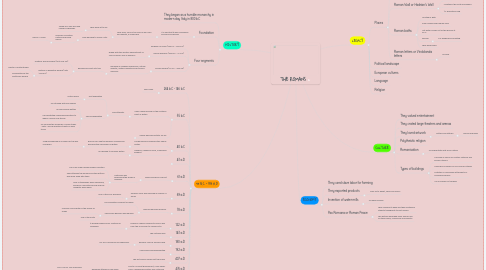
1. HISTORY
1.1. They began as a humble monarchy in modern day Italy in 800 b.C
1.2. Foundation
1.2.1. It is said that it was founded by Romulus and Remus
1.2.1.1. Twin boys, sons of the God of war Mars and Aeneas, a Greek hero
1.2.1.1.1. They were let to die
1.2.1.1.2. They decided to found a city
1.3. Four segments
1.3.1. Kingdom of Rome (753 b.C - 509 b.C)
1.3.2. Roman Republic (509 b.C - 27 b.C)
1.3.2.1. Ended with the senate's appointment of Julius Caesar's son as emperor
1.3.3. Roman Empire (27 b.C - 285 a.D)
1.3.3.1. Because of religious differences, natural disaster, military defeats and economic declines...
1.3.3.1.1. Bureaucrocy split into two
2. 55 B.C - 193 A.D
2.1. 264 b.C - 146 b.C
2.1.1. Punic wars
2.2. 55 b.C
2.2.1. Julius Caesar arrived on the southern coast of Britain
2.2.1.1. Two attempts
2.2.1.1.1. First expedition
2.2.1.1.2. Second expedition
2.2.2. Caesar became dictator for life
2.2.2.1. He was murdered
2.2.2.1.1. Civil war
2.3. 40 b.C
2.3.1. Cunha Bolinas conquered the Treena vantes
2.3.1.1. Bolinas' son fled the emperor Caligula and declared the submission of Britain
2.3.1.1.1. Caligula prepared an invasion but he was murdered
2.3.2. Claudius, Caligula's uncle, is declared Emperor
2.3.2.1. He decided to conquer Britain
2.4. 43 a.D
2.4.1. 40.000 men arrived in Britain
2.4.1.1. They conquered the south despite the British natives resisted fiercely
2.4.1.1.1. Rules allied the Romans and helped them to administrate the region
2.5. 61 a.D
2.5.1. Queen Boudicca's Revolt
2.5.1.1. Suetonius was suppresing the druids in Anglesey
2.5.1.1.1. The Iceni under Queen Boudica revolted
2.5.1.1.2. They attacked the Romans and the Brittons who were allied with them
2.5.1.1.3. Tens of thousands were massacred, Boudicca commited suicide and her daughter were raped
2.6. 69 a.D
2.6.1. Emperor Nero was declared an enemy of Rome
2.6.1.1. Year of the Four Emperors
2.7. 78 a.D
2.7.1. Agricola became governor
2.7.1.1. He completed conquest of Wales
2.7.1.2. The Roman garrison was reduced
2.7.1.2.1. Caerleon and Chester in the border of Wales
2.7.1.2.2. York in the north
2.8. 122 a.D
2.8.1. Emperor Hadrian ordered to build a wall from the Tyne River to Solway Firth
2.8.1.1. It divided England from Scotland or Caledonia
2.9. 143 a.D
2.9.1. The Antonine wall
2.10. 180 a.D
2.10.1. Emperor Marcus Aurelius died
2.10.1.1. His son Commodus succeded him
2.11. 192 a.D
2.11.1. Commodus was assassinated
2.12. 407 a.D
2.12.1. The last Roman soldier left the island
2.13. 476 a.D
2.13.1. Due to a corrupt government, a lazy upper class, a weakening military and a starving overtaxed lower class...
2.13.1.1. Barbarian attacks or Dark Ages
2.13.1.1.1. FALLING OF THE WESTERN ROMAN EMPIRE
2.14. 1453 a.D
2.14.1. The Eastern Roman Empire, also called the Byzantine Empire, prospered
2.14.1.1. Ottoman Empire attacked
2.14.1.1.1. FALLING OF THE BYZANTINE EMPIRE
3. LEGACY
3.1. Places
3.1.1. Roads, amphitheaters, buildings and cities
3.1.2. Roman Wall or Hadrian's Wall
3.1.2.1. 122 a.D
3.1.2.2. Located in the north of England
3.1.2.3. 117 kilometers long
3.1.3. Roman baths
3.1.3.1. Located in Bath
3.1.3.2. Small village called Aquae Sulis
3.1.3.3. Hot water comes out of the ground at 45°C
3.1.3.4. Popular
3.1.3.4.1. For washing and meeting
3.1.3.5. They were public
3.1.4. Roman letters or Vindolanda letters
3.1.4.1. On web
3.2. Political landscape
3.3. European cultures
3.4. Language
3.5. Religion
4. ECONOMY
4.1. They used slave labor for farming
4.2. They exported products
4.2.1. Olive oil to Egypt, Spain and Africa
4.3. Invention of water mills
4.3.1. To replace slaves
4.4. Pax Romana or Roman Peace
4.4.1. They reached its peak and they mantained stability throughout its vast empire
4.4.2. The Britons depended upon Roman rule for their peace, commerce and industry
5. CULTURE
5.1. They valued entertaiment
5.2. They crated large theaters and arenas
5.3. They loved artwork
5.3.1. Pottery and statues
5.3.1.1. Heroes and gods
5.4. Polytheistic religion
5.5. Romanisation
5.5.1. To differentiate elite from natives
5.6. Types of buildings
5.6.1. Coloniae or places for military veterans and Roman citizens
5.6.2. Municipia or places for non-Roman citizens
5.6.3. Civitates or romanized settlements of conquered people
5.6.4. Vici or places for tranding
